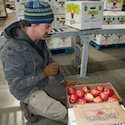 First Fruits of Washington is a marketing company and they sell apples. Red ones, green ones, yellow ones, and everything in between. First Fruits has more than 223 million pounds of apples to sell for the 2010 season.
First Fruits of Washington is a marketing company and they sell apples. Red ones, green ones, yellow ones, and everything in between. First Fruits has more than 223 million pounds of apples to sell for the 2010 season.
Andy Tudor, Marketing Director of First Fruits of Washington, describes the supply chain for the eleven types of apples his suppliers grow. And he tells us how a new variety of apple makes it to market.
GoodFood World: Let’s start at the beginning of the supply chain and lay out the connections from grower to consumer. What is the “grower/packer/shipper” relationship?
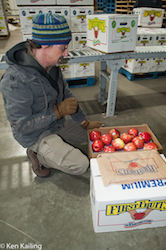 Andy Tudor: At First Fruits we work with three “grower/packer/shippers” Broetje Orchards, Columbia Valley Fruit, and Congdon Orchards. They grow the fruit, store and pack their own fruit and fruit for around 100 other growers, and ship the cartons to the buyers. To be able to ship apples to the final market, the shipper must have a commercially licensed warehouse. Food storage warehouses – fruit storage included – must be inspected and licensed.
Andy Tudor: At First Fruits we work with three “grower/packer/shippers” Broetje Orchards, Columbia Valley Fruit, and Congdon Orchards. They grow the fruit, store and pack their own fruit and fruit for around 100 other growers, and ship the cartons to the buyers. To be able to ship apples to the final market, the shipper must have a commercially licensed warehouse. Food storage warehouses – fruit storage included – must be inspected and licensed.
GoodFood World: As a marketing company, what is your working relationship with these companies? What do you do for them?
Andy Tudor: We are not just an outsourced sales and marketing company, we are actually owned and directed by our growers. We’re an integrated part of their operations. Our job is to find the best market for their apples.
Because we work in advance to set up contracts for the apples to be grown, we work out in front of our growers. The first step is to get an estimate of volume by variety and, as the season progresses, continually refine it. We build an estimate of the number of bins of each type of apple that will be produced during the period beginning late in August and running until about the middle of November.
Our job is to find the markets that will generate the best return for the growers and give the packer/shippers the information they need to package the fruit.
GoodFood World: Who is it that you sell the fruit to? Supermarkets, smaller markets, wholesalers, distributors?
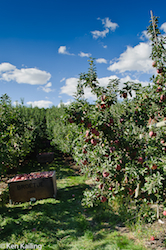 Andy Tudor: We sell domestically and around the world to retail chains and to wholesalers, both in the US and internationally.
Andy Tudor: We sell domestically and around the world to retail chains and to wholesalers, both in the US and internationally.
For example, we sell to large supermarket chains that will order truckloads – each containing 20 pallets of a single variety of apples – to be sent to one of their distribution centers. From that center, they breakdown the pallets and truck the individual boxes to their stores.
On the other hand, a wholesaler may order a 20-pallet mix of Grannys, Galas, Red Delicious, and Fujis. The wholesaler is likely to be located in a large market like LA, San Francisco, Chicago, or Boston. Smaller chains and independent retailers that don’t have enough volume to order a full load of apples from us will buy cartons from the wholesaler.
GoodFood World: For 2010, you project that about 22% of your production will be organic apples. Why not grow more? Why not 100% organic production?
Andy Tudor: As an industry, we try to maintain a balance of organic and conventional production. In the past, the premium on organic apples was as much as 35% to 40% above conventional apples. Over the past several years we have seen price equalization.
In the period between 2005 and 2008 a considerable amount of acreage was converted to organic and there were new plantings. As a result of increased supply, the prices have equalized to about 15% premium over conventional fruit.
Our largest grower is Ralph Broetje; he grows about 5000 acres of conventional fruit and about 1000 acres of organic. Ralph’s conventional acreage is about 99% organic; he incorporates integrated pest management, commercial fertilizer and just one post-harvest spray. Broetje Orchards could be certified organic in 3 years.
While we talked about doing that conversion 6 or 7 years ago, it would have buried the organic grower community in Washington. Broetje keeps the production at about 20% to sustain the organic farmers, rather than just chasing the dollars.
The key is to have the right mix of varieties that satisfies the palette of the organic consumers. There aren’t a lot of Red Delicious and Golden Delicious grown organically; our organic mix is primarily Gala, Fuji, Honey Crisp, Braeburn, and Pink Lady.
Be aware that of all the fruit grown organically, not all is sold as organic. There is a percentage that we pack conventionally because it’s either a size or a grade that doesn’t have a market for it. The fruit is then packed and sold as conventional.
GoodFood World: In the past, because there was a considerable premium on organic fruit, it was necessary to educate both the retailer and the consumer on the value of organic production. Has that changed?
Andy Tudor: Yes, we are seeing something new happening since the price is more or less equal. There are a few retailers that are now offering only organic rather than a choice between a variety in both organic and conventional.
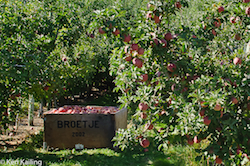 From August through February, while we’re at the peak quality and peak eating experience for organic fruit, there’s enough supply that these retailers are simply not giving the consumer a choice. It’s working very well for them.
From August through February, while we’re at the peak quality and peak eating experience for organic fruit, there’s enough supply that these retailers are simply not giving the consumer a choice. It’s working very well for them.
On the other hand, when you step back and look at the big picture, we’d like the opportunity to inform consumers about the value of organic production. We don’t always get the chance.
The committed organic consumer will seek organic products all the time, but the pricing has opened up the market to a new consumer who is paying only a little more than the price for a conventionally farmed apple and is getting to experience an organic apple. We’d like to be able to reinforce that experience.
GoodFood World: Looking forward, how do you help your growers develop and produce new varieties?
Andy Tudor: First Fruits was born out of necessity; we’re not a separate marketing entity with a separate agenda. We are an extension of our growers’ businesses. We actually occupy a space between the consumer and the grower; we have one foot in the field and one in the store, so to speak.
When we get information about a variety that consumers really like, we go back to our growers and say, “Look, this apple is a winner. We think we can market it at a profitable return for you.” To bring a new variety to market takes a huge investment on the grower’s part in time and money.
We have a number of new apple varieties under consideration, but it doesn’t take 14 days or even 14 months to bring them to market. Once the decision is made to bring a new variety to market it can take 14 years to reach a commercial volume.
We try to shorten the decision process for potential new varieties. There are some simple questions that need to be answered:
- Will it grow in our region?
- Will it produce fruit of sufficient and consistent size?
- Will you get enough volume from the trees?
Nurseries are always coming up with new varieties and they approach our growers to test them. The grower will plant a few trees and give the nursery feedback as they grow. When the trees start producing apples, we send samples to trusted industry experts and ask them for feedback.
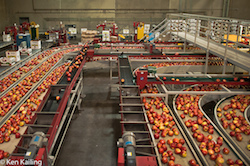 At that point we try to make a determination if it’s going to be a commercially viable variety because there’s only so much space for apples. It’s nice to think we’ll find the next Fuji or Gala, but it’s really competitive out there.
At that point we try to make a determination if it’s going to be a commercially viable variety because there’s only so much space for apples. It’s nice to think we’ll find the next Fuji or Gala, but it’s really competitive out there.
GoodFood World: What you’re describing is the industrializing of an apple. What about some of the niches, the heirloom varieties? Do you ever take on something unique?
Andy Tudor: There are growers that specialize in heirloom varieties. We sell hundreds of millions of apples a year. It takes a lot of energy and focus to move that many apples.
If you’re a grower with 1,500 or 2,000 boxes of five different heirloom varieties, it’s difficult for us to move that kind of volume through our distribution system. Niche growers with 40 acres of 10 different varieties can manage the volume and sell direct through farmers markets and online. That’s good for them; I expect that’s how it will remain.
For more information about First Fruits of Washington, visit the website here.

